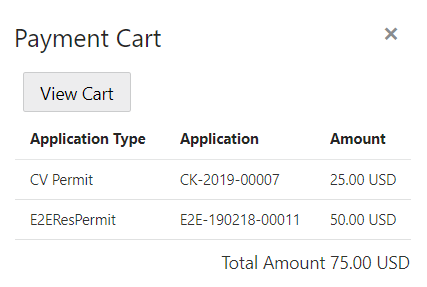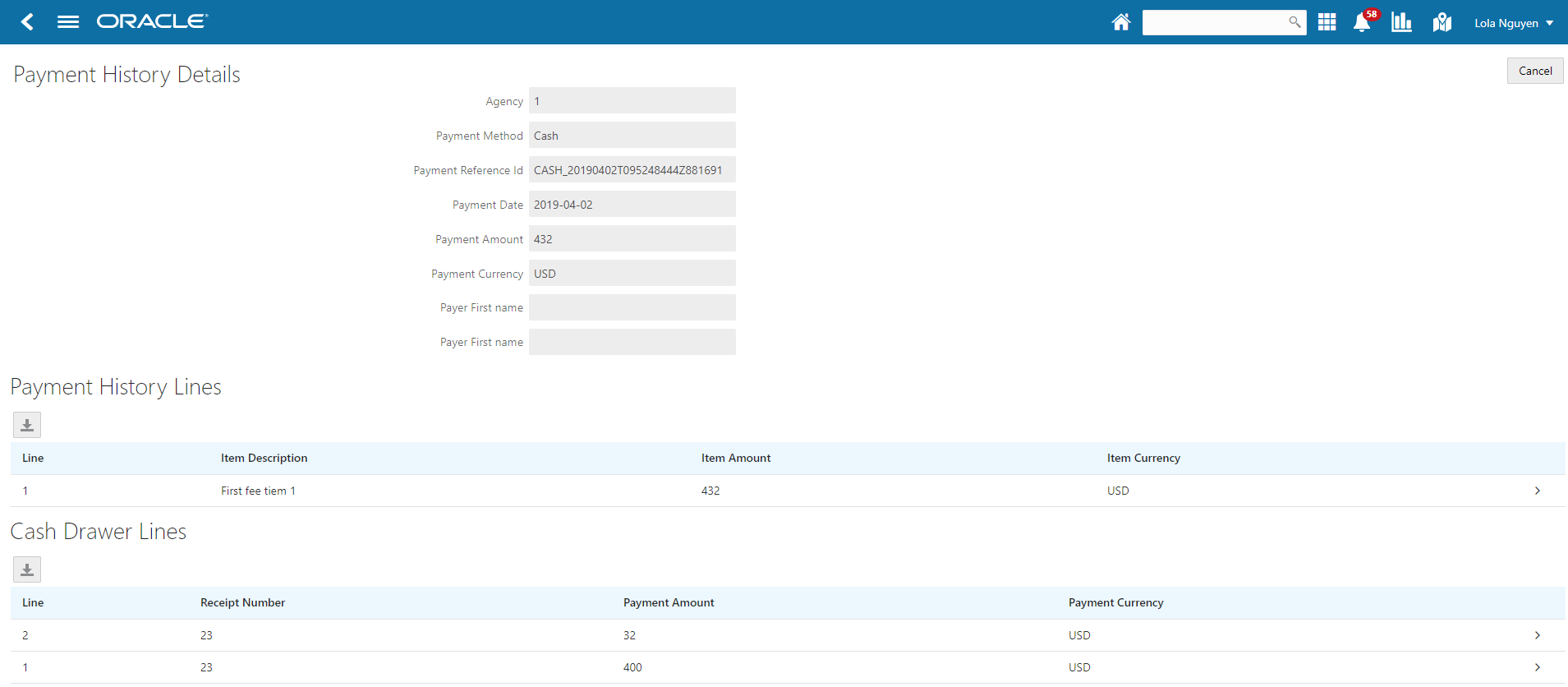9Working with Payments
Payment Flow Overview
This topic provides a high-level overview of fees and the payment flow. Applicants can make payments online, and agency staff can assist applicants with payments.
After completing an application for a permit, the fees are calculated and applied to the applicant’s account. The applicant manually adds fees to the payment cart, and selects which fees to pay in one transaction. Agency staff can initiate payment from the Permits list page or from the fees and payments page in the permit details. System processing for payments triggers workflow and generates accounting and invoices.
For information about setting up fees and payments, see the documentation for Implementing Oracle Public Sector Permits.
Understanding Fees
Some basics about fees include the following:
Fees for a permit are determined by decision modeling and associated with fee schedules.
Fees may be applied during the application process or later for additional fees or adjustments.
Fees appear on the My Permits page for applicants, on the Permits list page for agency staff, and on the Fees and Payments page in the permit details for both agency staff and applicants.
If a condition is applied to the permit, such as a hold or lock on the permit, the applicant may not be able to pay until the condition is resolved.
Agency staff can add or adjust fees on the Fees and Payment page in the permit details.
Fee Payments Process for Applicants
Applicants can make a payment by following this process:
On the My Permits page, add fees items to the payment cart.
Select fees for payment in the payment cart.
Fees not selected for payment remain in the cart.
Click the Continue to Checkout button.
Review the Checkout page, which lists the different secured payment methods available.
Only agency staff can process cash and check payments.
Select one of the payment methods for payment processing.
Depending on the payment service being used, the payment steps differ.
After successful payment, the applicant is returned to the My Permits page.
Fee Payments Process for Agency Staff
Agency staff can use the following process to assist an applicant with a payment:
Click the Pay button for a permit listed on the Permits page or on the Fees and Payments page in the permit details.
Agency staff skip the payment cart and go directly to the Checkout page.
Review the Checkout page, which lists the different payment methods available, such as cash or check.
Select one of the payment methods for payment processing.
Depending on the payment service being used, the payment steps differ.
After successful payment, the agency user is returned to the Permits list page.
Payment Cart Overview
Applicants can pay fees over the Internet using a payment cart and checkout process. The Cart page is used to accumulate fees and review them before making a payment.
The payment cart shows fees associated with applications belonging to one customer profile at a time. When a user switches profiles, the payment cart is updated to show fees for the selected profile.
Viewing Fees in the Payment Cart Summary
The payment cart icon appears in the global header when a registered user logs into Oracle Public Sector Community Development. The number of items in the payment cart, if any, appears on the icon:
This is an example that illustrates the payment cart icon, showing 17 items for payment in the cart.

Clicking the payment cart icon opens the Payment Cart summary page, which lists the fees that are awaiting payment:
This example illustrates the Payment Cart summary page.

If the cart is empty, the summary of fees is not available.
Clicking the View Cart button opens the Cart page.
Paying Fees in the Payment Cart
The system applies fees to the user's account when an application is submitted. The applicant can then move fees into the payment cart, where the fees remain until the applicant pays the fees. Fee adjustments are automatically reflected in the cart before checkout processing.
This example illustrates the Cart page. In this example, the items belong to one or more projects defined by the agency.

| Page Elements |
Usage |
|---|---|
 |
Click to group the fees by Address or Application Type. |
 |
Click to sort the fees by Added Date, Application Type, or Application. |
| Total Amount |
Review the number of items to pay now and the total amount selected for payment. |
| Application number |
Click the application number—for example, RA-2018-0008—to open a page with the application details. |
|
|
Click the projects link next to the application number to see a list of the projects to which this application belongs. |
| Application type |
View the type of application, such as Residential Addition. |
| Fee amount |
View the fee amount for the application, for example: $215.17. Click the fee amount link to open the Fee Detail page, which shows a breakdown of the fees and the total fees due for the application. |
 |
The Fee Amount Changed alert indicates the fee has been adjusted. Adjusted fees are updated automatically in the cart before checkout processing. |
| Property address |
View the location of the property to which the fee applies. |
| Aging information |
View the aging information for the fee, for example: Added 5 days ago. |
Conditions that have been applied to the application appear as icons next to the application ID. For more information about conditions, see Applying Conditions to Applications and Setting Up Conditions.
After reviewing fees, the applicant can choose from several actions:
| Page Element |
Usage |
|---|---|
| Continue to Checkout |
Click the button to continue to checkout with the fees selected to pay now. |
| Pay Now |
Select the fees for payment by turning on the Pay Now switch. |
| Remove from Cart |
Click to remove a fee from the cart. Removing fees from the cart does not affect the application. The user can make changes to the application if needed and add the fees to the cart later. |
| Return to Applications |
Click the link to return to the user’s Applications page. |
The system validates the application in the payment cart and identifies applications with a conditional status. The applicant must correct any conditions associated with an application before proceeding to checkout.
Users cannot make any changes to the application and associated fees submitted for payment during processing. After the payment processing is complete, the items are removed from the cart, and the system directs the user back to the Cart page to pay remaining fees. If the cart is empty after a successful payment, the user is directed their Applications page. If the payment fails, the fees remain in the cart and can be updated or resubmitted for payment.
Working with Cashier Sessions
Cashier sessions are instances of a cashier using a specific cash drawer to receive payments from customers. Cashiers add and modify cashier sessions on the Cashier Session page.
Opening a Cashier Session
Select .
On the Cashier Session page, click Add.
On the Cashier Session Details page, enter values for the following fields:
Page Element
Description
Cashier Drawer ID
Select the cash drawer that you want to use for this session.
Session ID
Displays the unique, system-generated ID for the cashier session.
Start Time
Displays the date and time the session was created.
Status
All new cashier sessions have a status of Open.
Cashier ID
Displays the unique ID of the cashier who is opening the cashier session.
Administrators assign cashier IDs to agency staff on the Agency Staff page. You cannot open a cashier session if you do not have a cashier ID assigned to you.
Opening Balance
Enter the amount in the cash drawer at the beginning of the cashier session.
Click Save.
Modifying a Cashier Session
Select .
Click a row with a status of Open or Suspended on the Cashier Session page.
Note: You view cashier sessions with a status of Closed, but you can’t edit them.On the Cashier Session Details page you can:
Suspend an open cashier session by setting the Status to Suspended.
Reopen a suspended cashier session by setting the Status back to Open.
Close a cashier session by setting the Status to Closed. When you close a cashier session enter an amount for the Closing Balance.
Note: The system populates the End Time field with the date and time the session was closed.
Click Save.
Printing Deposit Slips
Agencies that collect payments use deposit slips to deposit the money collected in the form of cash and checks into the agency's bank account.
You print deposit slips using the Print Deposit Slip page.
Prerequisites
Before you generate deposit slips for your agency, you must define the P_DEPOSIT_SLIP_NUMBER parameter for the Deposit Slip (DepositSlip001) report. For more information on defining report parameters, see Setting Up Reports.
Generating Deposit Slips
Select Billing and Payment, Deposit Slip.
On the Print Deposit Slip page, enter values for the following fields:
Page Element
Description
Agency ID
Select the agency for which you want to print a deposit slip.
From Receipt Date and To Receipt Date
Select the date range of receipts that you want to include in the deposit slip.
Payment Method
Select the payment methods that you wanted to include in the deposit slip. Options are Cash, Cashier Check, and Personal Check.
Cash Drawer ID
Select a value to print a deposit slip for the receipts of a specific cash drawer. If you leave this field blank, the deposit slip will include all cash drawers for the specified date range.
Session ID
Select a value to print a deposit slip for the receipts of a cashier session. If you leave this field blank, the deposit slip will include all cashier sessions for the specified date range.
Cashier ID
Select a value to print a deposit slip for the receipts of a specific cashier. If you leave this field blank, the deposit slip will include all cashiers for the specified date range.
Note: The values available in the Cash Drawer ID, Session ID, and Cashier ID drop-down fields represent the cash drawer payment history rows within the entered date range that have not yet been printed. Therefore, the values available in the drop-down fields change based on the entered date range. If a selected drop down value becomes invalid because you change the date range, the field with the invalid value becomes blank. If the selected drop-down value remains valid after changing the date range, the drop-down value is unchanged.Click Print. The generated deposit slip file opens in a separate browser tab.
Note: If your browser has a pop-up blocker, make sure it allows pop-up windows from the URL associated with Oracle Public Sector Compliance and Regulation.
Viewing Payment History
Agency staff can view payment history on the Payment History page.
This example shows the Payment History page.

Reviewing Payment History
Select in the navigator.
Note: Registered public users can also access this page from the Registered Public Landing Page by selecting View Payment History from the I Want To field. Public users can view only the payments that they submitted.The Payment History page displays all of the payments received by the agency. You can search for and sort payments by:
Payment method
Payment reference ID
Payment date
Payment amount
Payment currency
Payer first name
Payer last name
Record ID
Record type
Select a payment to view additional details on the Payment History Details page.
This example shows the Payment History Details page.

The Payment History Lines grid displays the transaction lines associated with the payment. You can select a payment history line to view additional details on the Payment History Line Details modal page.
The Cash Drawer Lines grid displays the cash drawer transaction lines associated with the payment. You can select a cash drawer line to view additional details on the Cash Drawer Line Details modal page.
